2. The extent and nature of Soviet control
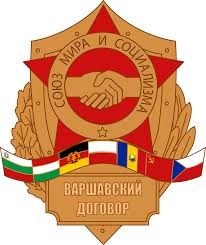
In the years 1945 to 1950, Stalin established political control over the eastern and central European states; he also tied them economically to the USSR and, via the Warsaw Pact, secured military control. Only Yugoslavia under Tito resisted Soviet domination.
Guiding Questions:
How did the Soviet secure political control over central and eastern Europe?
What were the economic developments in central and eastern after 1945?
What was the Warsaw Pact and why was it established?
How did Tito’s Yugoslavia challenge Soviet control?
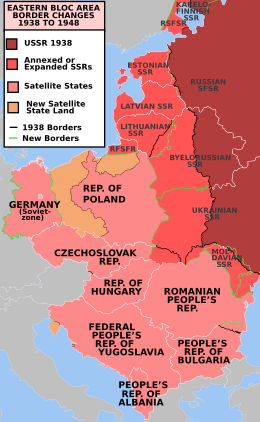
1. How did the Soviets secure political control over central and eastern Europe?
The Soviet Union gained increasing political control over eastern Europe using a method dubbed ‘salami tactics’ by Hungarian Communist leader, Matyas Rakosi; the USSR would orchestrate the removal of all other political parties in stages, ‘like slicing of a salami, piece by piece’:
In addition to salami tactics, men known as the ‘Baggage Train’ leaders, obedient to Moscow who had spent most of the war in the USSR, were returned to eastern Europe: to Poland – Bierut, to Hungary – Rakosi, to Bulgaria - Kolarov and to Romania – Pauker:

The free elections that Stalin had agreed to hold did not take place until January 1947. Prior to these elections there was a campaign of intimidation, censorship, arrest and murder. It is estimated that more than 50 000 people were deported to Siberia from eastern Europe before the elections.
Indeed, from 1946 the extent of Soviet control over central and eastern European states increased. Each country had become a ‘police state’ by the end of the 1940s. The secret police forces were moulded on the KGB, and exercised control over the population via surveillance and widespread use of informants.
There was tight control of the media, well organised propaganda and total control over education. It was compulsory to teach and learn Russian in schools. Society was also indoctrinated and mobilised by mass parades and rallies and in some countries there was the promotion of cults of personality, for example, Ceausescu in Romania. Organisations of friendship were set up with the USSR. Soviet films and books were imported, and socialist holidays replaced national public holidays. Each state also had its own communist youth movement.
All central and eastern states under Soviet domination were single party states. Where other parties were allowed to exist this was only to give the semblance of democracy. For example other parties were permitted in East Germany but these had to be obedient to the Socialist Unity Party. Elections were held only to give the ruling group ‘legitimacy’; only the official candidates could stand and while mass participation was encouraged in these elections, the results were predetermined.
Nationalist sentiments were suppressed and each state followed the doctrine of Soviet Marxist-Leninism. In addition to the presence of Soviet trained leaders in each country, the USSR kept a close watch on each state through its embassies. Political organizations were structured: local party organizations elected members to intermediate organizations who in turn elected members of government. Candidates were selected, and government posts were appointed by the central committee. The politburo of each state actually determined policy.
It is important to note that Soviet trained people were placed in all key positions in each state, including in the security services. The USSR also isolated the satellite states from each other. Good jobs in each state were reserved for those with party membership. The Nomenklatura system emerged, where a new social elite formed based on party membership and political obedience. By 1950 Polish communist party membership had increased to 1.2 million and in Czechoslovakia to 1.5 million by 1954.
Religion was also suppressed. In Poland, Catholicism was a powerful force which could challenge Soviet influence. The new communist Polish government separated church and state, and nationalized church property. The Lutheran churches in East Germany, and the churches in Romania and Czechoslovakia were also persecuted. Government agencies were set up to monitor religious activity.
A key facet in the nature of Soviet domination was the use of force and intimidation to maintain the regimes in central and eastern Europe. There were purges and mass arrests. Thousands of political prisoners were sent to new camps, similar to the Gulag. For example there were 97 concentration camps in Poland by 1950. When it was suspected that arms from Yugoslavia to Israel were being transported via Czechoslovakia, Stalin believed the state was harbouring Titoist agents. In the ensuing purge, half of the central committee was removed, and 500,000 party members were purged. By the 1950s, Czechoslovakia had 124 concentration camps. Similarly in Hungary in the early 1950s, 200,000 party members were purged and the state had set up 199 concentration camps. There was also oppression and purging in Romania and Bulgaria.
The chart below gives brief outlines of how political control was secured in each country.
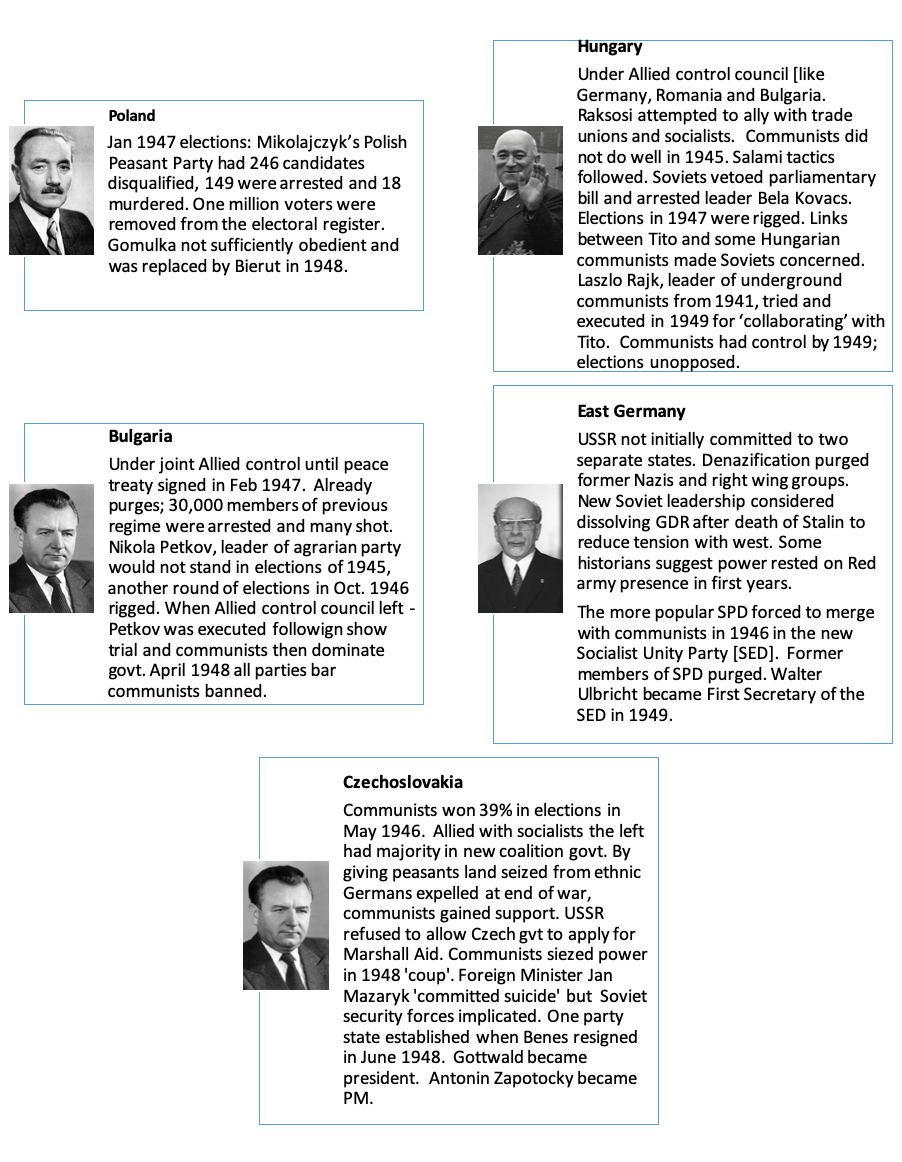
ATL: Research skills.
In small groups review the material above.
1. Research further the methods used by the Soviet Union to shape and control politics and society in central and eastern Europe. Each group should take a different country and build on the information provided in the diagram above. Refer the chart below to guide your lines of inquiry, and attempt to cover each theme.
2. Once you have done this, discuss in pairs or in small groups the nature and extent of Soviet domination in central and eastern Europe by the early 1950s.

Task Two
ATL: Thinking skills
In pairs have a look at this David Low cartoon entitled 'Who's next to be liberated from freedom, Comrade?"
What is the message of this cartoon?
2. What were the economic developments in central and eastern after 1945?
 https://www.loc.gov/exhibits/herblocks-history/ticktock.html
https://www.loc.gov/exhibits/herblocks-history/ticktock.html
Starter: What is the message of this cartoon by Herblock?
Under Soviet domination the satellite states adopted soviet-style economic policies, for example centrally planned economies, nationalization of land and industry, collectivization in agriculture and 5 year plans for industry. In January 1949, COMECON, the Commission for Mutual Economic Aid, was set up by the USSR. Its founding members were the USSR, Poland, Czechoslovakia, Romania, Hungary and Bulgaria. At the time, COMECON was deemed by the West as the Soviet response to the Marshall Plan
See 1.1 Theme 1 - Rivalry, Mistrust and Accord (ATL) for more discussion and video links for the Marshall Plan
Why did the USSR set up COMECON?
The Soviets wanted to ensure closer economic cooperation between itself and each of the central and eastern European states under its control. It publicly declared that these states did not want to ‘subordinate’ themselves to US Marshall plan assistance as this would interfere with their sovereignty. However, COMECON had both economic and political aims.
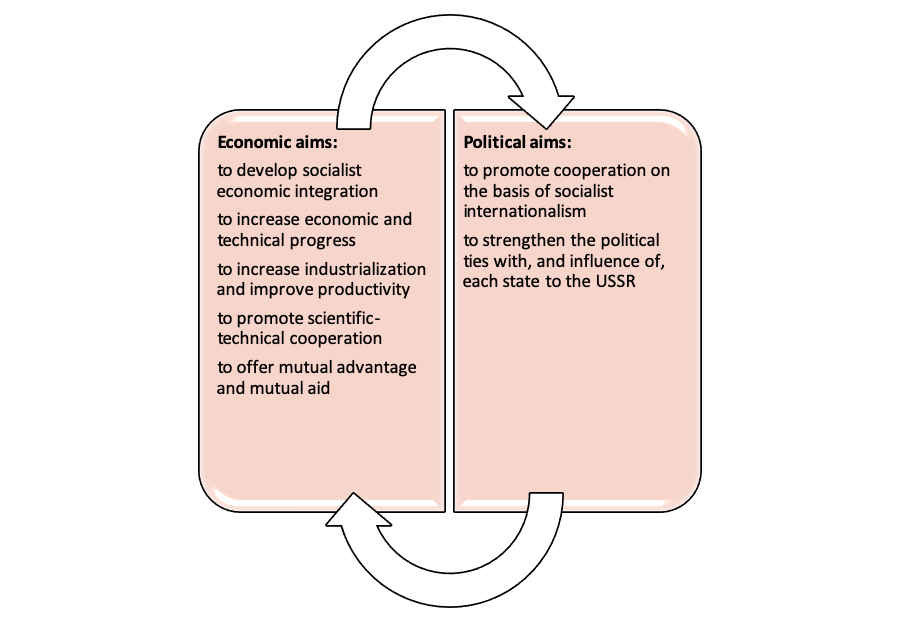
Although set up in January 1949, the organization was not very active until a more formal structure was agreed in 1959. Up until then states generally planned their own command economies. However the Sofia Principle, established in August 1949, made each country's technologies available to the others for a very small fee and this benefitted greatly the less industrialized and technologically advanced states - including the USSR itself - to the detriment of East Germany and Czechoslovakia.
In 1950 Stalin, apparently concerned with each state’s nominal autonomy, limited the scope of consensus agreement within COMECON’s members to questions of trade. Indeed, the USSR dominated the organization and COMECON coordinated 5 year plans, and promoted specialization within each state. ‘Specialization’ tended to focus on the needs of the Soviet economy. COMECON also facilitated cooperation in production of chemicals and in engineering. The Soviets had promoted a focus on industry in East Germany and pressured the other states to develop their agricultural sectors. Romania resisted this; it argued that as a Marxist state it should be encouraging the growth of industry. In fact, there is evidence to suggest that COMECON was a result of an idea advocated by Romanian leader Gheorghe Gheorghiu-Dej in 1948 to foster industrial development across the Eastern bloc.
The reality was that most trade agreements were signed bi-laterally between the USSR and individual central and eastern European states. This maintained Soviet domination and reinforced the isolation of each state. Indeed COMECONs ‘pricing system’ favoured the USSR, although it did at times give credit to struggling member states. The basis for trade / cooperation was that the USSR offered raw materials and energy supplies in exchange for manufactured goods.
Task One
ATL: Thinking skills
Read these two clauses which set out the purposes and principles of COMECON
1. According to these clauses, what economic benefits would the member countries receive?
2. To what extent were the purposes and principles set out here actually carried out?
1. The purpose of the Commission for Mutual Economic Assistance is to promote, by uniting and coordinating the efforts of the member countries of the Commission, the further deepening and perfecting of cooperation and the development of socialist economic integration, the planned development of the national economies and the acceleration of the level of industrialization of the countries with a less-developed industry, a continual growth in the productivity, the gradual approximation and equalisation of the levels of economic development, together with a steady increase in the welling of the peoples, of the member countries of the Commission.
2. The Commission for Mutual Economic Assistance is based on the principle of the sovereign equality of all the member countries of the Commission. Economic and scientific-technical cooperation between the member countries of the Commission shall take place in accordance with the principles of socialist internationalism, on the basis of respect of state sovereignty, independence and national interest, non-interference in the internal affairs of countries, complete equality of rights, mutual advantage and friendly mutual aid.
Task Two
ATL: Thinking skills
In pairs discuss the reasons for the establishment of COMECON and what potential role it played in maintaining Soviet dominance over central and eastern European countries.
3. What was the Warsaw Pact and why was it established?
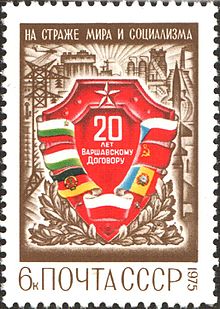
The Warsaw Pact was another means of expanding and consolidating Soviet control in the region. The key motive for its establishment was in response to the US setting up the North Atlantic Treaty Organization [NATO] in April 1949 after the Berlin Blockade. In this sense, the Warsaw Pact was a defensive move, as the US’ alliance posed a significant threat to communist regional security. Its purpose was also a means to strengthen the Soviet military as Warsaw Pact forces could be deployed to reassert control should a ‘satellite’ state attempt to oppose the authority of the USSR.
Soviet stamp commemorating the 20th anniversary of the Warsaw Pact in 1975 stating that it remains "On guard for Peace and Socialism'.
The Warsaw Pact was deemed in the West as purely a tool for the Soviets to exercise control over eastern Europe. Central and eastern European states had, from 1948, signed bilateral military treaties with the Soviet Union. However, there were disputes from its inception with regards to its primary purpose - whether its aim was to strengthen the military security of central and eastern Europe or whether its focus should be to further the Soviet’s political aims. Historian Christopher Jones claims that it was essentially a political tool in that as member states had to rely on the USSR for defence then their political dependency would also be guaranteed. But, initially, there was talk in the USSR of using the alliance as a diplomatic pawn to negotiate the disbandment of NATO.
Indeed, when NATO was established the USSR consistently urged the US to disband the alliance, suggesting that alliance blocs would escalate tension and make a hot war between the superpowers and their allies more likely. The Soviets even proposed, in March 1954 , that the USSR could join NATO ‘to secure peace’. This was flatly rejected by the US and Britain.
As you have already found, the primary fear of the USSR was a resurgent, rearmed Germany. Therefore, when, against strong opposition from the Soviets, West Germany joined NATO in 1955 the USSR had to respond. The assumption was that any direct conflict with the US was likely to be fought over Germany. The Warsaw Pact alliance was signed in May 1955 in Poland, and East Germany was one of the founding members. East Germany was subsequently permitted to have an army and to rearm as a counter-balance to the rearmament of West Germany. The other member states were Albania, Bulgaria, Poland, Czechoslovakia and Romania.
Member states committed to political and military agreements. Of the member states Poland developed the biggest army, although the East German forces were the better trained. The Warsaw Pact’s Political Consultative Committee met quite regularly to discuss strategy and foreign policy. The treaty stated that there was a ‘policy of non-intervention in internal affairs of member states’– but this was not adhered to by the USSR. Indeed, the alliance would be used by the Soviets to enforce its control with military interventions, for example the invasion of Hungary in 1956. As Warsaw Pact forces were used, these interventions could be presented as multi-lateral socialist actions. The dominance of the Soviet Union over the alliance can be seen in the ration of troops: in the Warsaw Pact Soviet troops outnumbered those from other member states 4:1, in NATO other allied troops outnumbered those from the US by 3:2.
Task One
ATL: Thinking skills
In pairs read through the terms of the Warsaw Pact which can be found here and answer the questions that follow:
- What do the signatories commit to in terms of mutual defense?
- What other types of ‘friendship’ is encouraged in the terms?
- In what ways does the refer to the authority of the United Nations?
- Who was able to join [accession] the Warsaw Pact?
- What is meant by a ‘collective security’ treaty?
Task Two
ATL: Self-management skills
In pairs discuss how COMECON and the Warsaw Pact facilitated Soviet domination over central and eastern Europe.
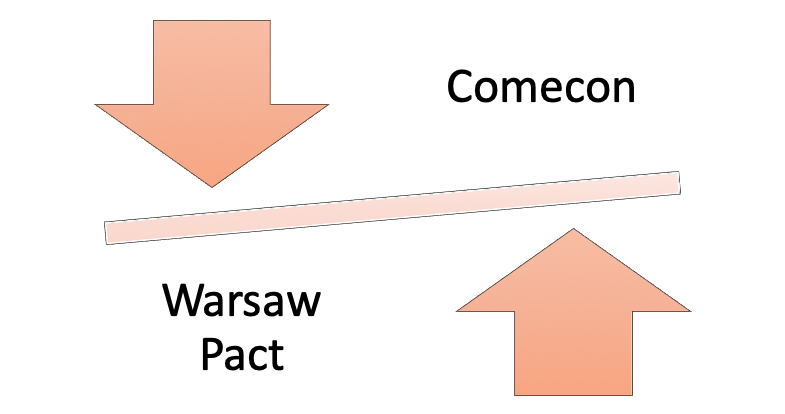
4. How did Tito’s Yugoslavia challenge Soviet control?
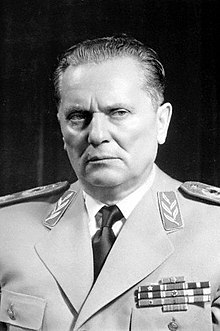
‘[Tito] was first man to stand up to the Soviet attempts to dominate Europe after World War Two... He broke whole idea of international communism.. he became the destroyer of communism’.
Richard West
Josip Broz Tito had had a tough childhood in Croatia and when the First World War broke out he was called up to fight for the Austro-Hungarian armed forces. During the war he became the youngest sergeant-major in the Habsburg army, and demonstrated that he was both brave and a natural leader of men. In 1915 he was wounded and taken prisoner, and was a Russian POW when the Bolshevik revolution overthrew the Tsarist regime in October 1917.
Tito escaped Russia and returned to his homeland, which was then a territory within the newly created Yugoslav state [December, 1918]. Politicised by his experiences, he challenged the idea of monarchical rule in Yugoslavia and the abject conditions for workers and peasants. Although the communist party was banned in Yugoslavia, Tito was involved in the underground communist party and was arrested for distributing communist propaganda in 1928. At his trial he shouted ‘long live the communist party, long live the world revolution!’ After his release from five years in prison, he worked for the Soviet Union as an international spy. The last alias he adopted as an agent was a common Croatian name – Tito.
By 1940 he was leader of the small Yugoslav communist party which aimed to overthrow the monarchy, and set up a communist government. However, in April 1941 Nazi Germany invaded Yugoslavia. German aerial bombardment devastated Belgrade, and within a week Hitler had seized control of the country and forced the monarchy into exile. Historian Stevan K. Pavlowitch suggests that Tito now saw his chance to ‘ferment revolution during occupation’.
What happened in Yugoslavia during the Second World War?
The Germans used a ‘divide and rule’ policy in Yugoslavia, and utilised historic religious hatreds to control the multi-ethnic population. The Ustaše, a group of radical Croatian separatists who wanted to destroy the Orthodox Christian Serbians were armed and unleashed by the Nazis. The slogans of the Ustaše declared that Serbs would be killed if they did not convert to Roman Catholicism and aimed to ‘expel one third and kill one third’ of the Serbian population. The brutality and atrocities of the Ustaše drove thousands of Serbs to join the communist partisans. Tito had begun to wage a guerrilla war against the German occupation, however he had no intention of reinstalling the ousted monarchy. Although incurring high casualties, the partisans were sufficiently effective for Hitler to order that for every one German killed, 100 civilians would be shot. However this order backfired as, by such actions, the Germans galvanized more recruits for the partisans.
From 1942, Hitler feared that there would be an attempt by the western allies to liberate Europe through the Balkans. A bounty of 100,000 Reichsmarks was issued for the capture, dead or alive, of Tito. However, Tito was engaged in fighting not only the German occupiers, but also pro-monarchist Yugoslav forces. In secret, Tito made contact with the German authorities to arrange a short-term ‘live and let live’ policy; however Hitler roundly rejected this and stated: ‘I never parlez with rebels. I shoot rebels.’
In June 1943, having managed to allude German forces by maintaining the mobility of his forces, Tito and his 20,000 partisans were surrounded by 120,000 Italian and German troops. It seemed that Tito was trapped and doomed. But after ten days of relentless attacks, Tito’s forces managed to escape. This gave Tito widespread acclaim and sealed his reputation as a Yugoslav hero and the nations ‘saviour’. Within months of this daring escape Tito commanded 220,000 men.
Tito’s aim was to liberate Yugoslavia with himself as head of a communist government. After capturing a small printing press, Tito expended great energy and resources on producing propaganda. This not only promoted a communist agenda, and rallied people against the German fascists – it also condemned Yugoslav royalists as ‘German collaborators.’
Tito’s greatest propaganda coup came in August 1944 when he met British prime minister Churchill. Tito declared in a speech that: ‘the people of the new Yugoslavia have the same aims as the people of Great Britain’. At the same time he made commitments about post-war democracy, freedom of the press and freedom of movement. Nevertheless, Tito also worked hard to prevent the West from claiming the liberation of the Balkans. After his meeting with Churchill, he flew to Moscow to convince Stalin to send forces to Belgrade before the West.
After Soviet offensives, partisan campaigns and sustained air support from the Western Allies the Germans were pushed into retreat in the late summer of 1944. In August 1944 Tito had offered an amnesty to ‘collaborators’ and in September the Yugoslav king, in exile, gave a radio broadcast urging all Serbs, Croats and Slovenes to join Tito’s National Liberation Army. Together with the Red Army, Tito’s forced seized Belgrade on 20th October. However, the fighting in Yugoslavia continued even after the surrender of Germany in May 1945. The Battle of Poljana, in Slovenia lasted until 15 May 1945. Tito’s forces finally defeated a combined force of Germans, Ustaše and other anti-partisan forces. The final battle of the war, the battle of Odzak ended on 25 May 1945. Yugoslavia was finally liberated.
Therefore, due to his heroic leadership of the partisan resistance to the Nazi occupation, his defence of Yugoslavia as a multi-ethnic federal state and the fact that he had liberated the country with only limited help from the USSR, Tito’s leadership of the post-war government had been achieved by his own actions. Tito’s communist government was not reliant on Soviet support. Indeed, unlike the other ‘satellite’ states his government had not been installed by the Soviet Red Army which had left Yugoslavia at the end of 1944. Significantly, Tito refused to be obedient to Moscow, and determined to pursue Yugoslavia’s ‘own path to socialism’.
How and why did Tito resist Soviet domination?
Task One
ATL: Thinking and communication skills
Watch the following documentary from 22.06 – 33.28 minutes and answer the questions below.
Questions
- What did ‘rumors’ suggest the letters T-I-T-O stood for?
- What happened to other political parties and to dissidents in Yugoslavia after 1945?
- Why did Yugoslavia shoot down two US aircraft in 1946?
- Whilst Tito embarked on a program to make Yugoslavia self-sufficient – what did Stalin want all eastern bloc countries to contribute to?
- Which country did Stalin order Tito to join in a new federation in 1948?
- When Tito refused, Stalin removed him from which organization?
- Which eastern bloc countries subsequently suspended trade with Yugoslavia, leading to the collapse of its economy?
- At the end of 1948 which country’s army was ordered by the Soviets to prepare for an invasion of Yugoslavia?
- Where was the Yugoslav-Soviet split seen as an ‘elaborate deception’?
- When asked by Czech communists why he did not invade to overthrow Tito – what did Stalin say?
- What was the agreement made between US President Truman and Tito at the beginning of 1949?
- In what way did the US administration link the outbreak of the Korean war to the Yugoslav-Soviet split?
- What did the US give Tito, covertly, in 1950 and 1951?
- What were the results of this ‘new relationship’ with the US for Yugoslavia?
4. What was the result of Tito’s challenge to Soviet domination?
Tito’s Yugoslavia benefitted from trade with the west and economic aid. Although the larger industries remained under state control, local managers were given more decision-making power. Some private ownership was permitted. The initial period of arrests and killings as a means of political control ended, and there was some limited liberal reform. This alternative path to socialism was termed Titoism.
Tito had survived, and Yugoslavia’s example would go on to be the foundation for the Non-aligned movement of countries during the Cold War that stood against alignment with either superpower. Stalin subsequently unleashed a series of purges across eastern Europe of suspected ‘Titoists’. The persecution included the Hungarian Foreign Minister Laszlo Rajk deemed a Titoist sympathiser. Those purged would be were demoted, imprisoned or executed during the late 1940s.
But the repression could not remove the inspiration for challenging the repression and control of the Soviet backed regimes in central and Eastern Europe. Indeed, from 1948 there would be a number of challenges to Soviet dominations: East Germany in 1953, Poland and Hungary in 1956, Czechoslovakia in 1968, and Poland in the 1980s. As Richard West suggested (see quote above), Tito was the first man to stand up to Soviet attempts to dominate Europe and ultimately, even though he was a communist, he planted the seed that destroyed communism in the region.
Task One
ATL: Thinking and communication skills
In pairs draft an article on: Yugoslavia’s challenge to Soviet control. You should include in your article the events that led to Tito establishing a communist government in Yugoslavia, and the reasons for the split with the USSR.
Make sure you have interviews with Yugoslav partisans and supporters of Tito as well as anti-Tito Yugoslav monarchists. Include the Soviet response to his refusal to comply with Stalin’s orders and a comment from a member of US President Truman’s administration on the ‘new relationship’ that has developed.

 IB Docs (2) Team
IB Docs (2) Team
